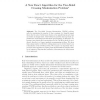Free Online Productivity Tools
i2Speak
i2Symbol
i2OCR
iTex2Img
iWeb2Print
iWeb2Shot
i2Type
iPdf2Split
iPdf2Merge
i2Bopomofo
i2Arabic
i2Style
i2Image
i2PDF
iLatex2Rtf
Sci2ools
COCOA
2007
Springer
2007
Springer
A New Exact Algorithm for the Two-Sided Crossing Minimization Problem
The Two-Sided Crossing Minimization (TSCM) problem calls for minimizing the number of edge crossings of a bipartite graph where the two sets of vertices are drawn on two parallel layers and edges are drawn as straight lines. This well-known problem has important applications in VLSI design and automatic graph drawing. In this paper, we present a new branch-and-cut algorithm for the TSCM problem by modeling it directly to a binary quadratic programming problem. We show that a large number of effective cutting planes can be derived based on a reformulation of the TSCM problem. We compare our algorithm with a previous exact algorithm by testing both implementations with the same set of instances. Experimental evaluation demonstrates the effectiveness of our approach.
Related Content
| Added | 07 Jun 2010 |
| Updated | 07 Jun 2010 |
| Type | Conference |
| Year | 2007 |
| Where | COCOA |
| Authors | Lanbo Zheng, Christoph Buchheim |
Comments (0)

